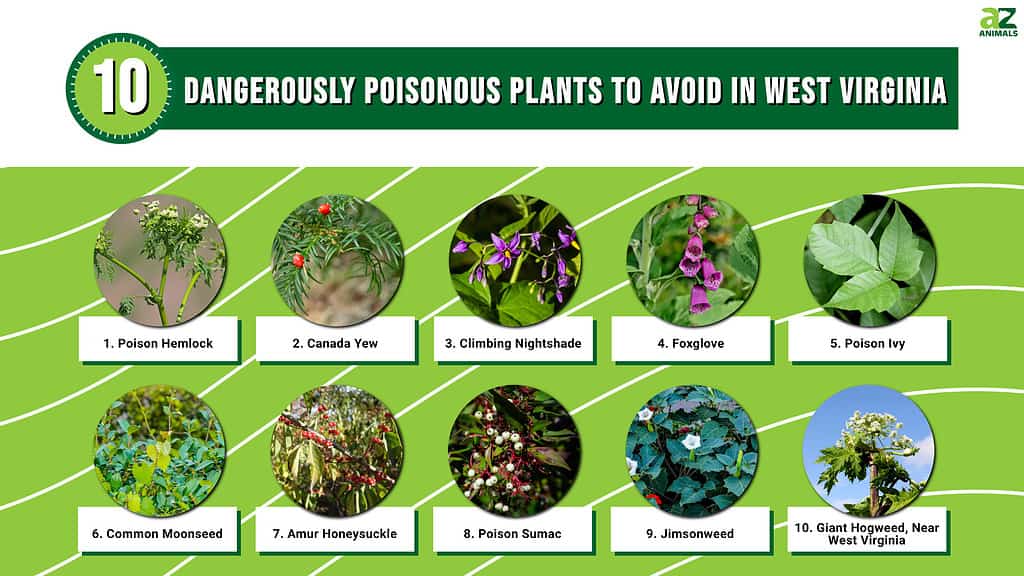
West Virginia is a gorgeous state with abundant natural beauty. Whether a person is hiking in the state’s mountains or fishing in the Ohio River, there’s always a good reason to be outside. Unfortunately, some of the wildlife and plants in West Virginia are dangerous to people and animals. Discover 10 of the most dangerously poisonous plants to avoid in West Virginia and learn where they grow, what they look like, and what they can do to a person.
1. Poison Hemlock
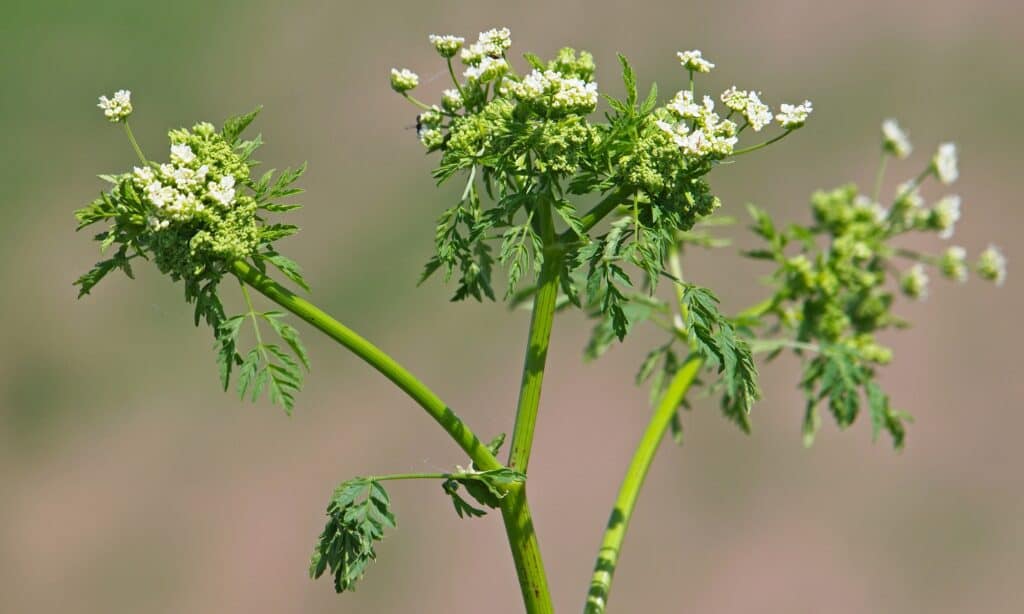
Poison hemlock thrives near pastures and rivers.
©iStock.com/emilio100
The poison hemlock plant, Conium maculatum, is a member of the family Apiaceae, making it related to carrots and celery. However, it’s a very good idea to not touch or eat this plant. Poison hemlock often grows in open areas, by streams, and near ditches.
The plant is most dangerous when it’s consumed, and it can cause a variety of symptoms that may result in death. Also, the plant’s sap can cause blisters or a rash when it touches the skin.
Poison hemlock does not have purple spots on its stems like water hemlock, one of the most dangerous plants in the United States.
2. Canada Yew

The Canada yew’s berries are poisonous to humans and animals.
©Kendal Swart/Shutterstock.com
The Canada yew, Taxus canadensis, is another one of the most poisonous plants to avoid in West Virginia. This shrub is commonly seen in areas near bodies of water like swamps, lakes, and rivers. This plant is relatively short, measuring about 3.5 feet tall.
The plant itself contains toxic alkaloids, but the seeds in the plant’s bright red berries are the most worrisome aspect of the plant as far as humans are concerned. The berry is bright and attractive, and it could make the seeds more likely to be consumed by a human. The plant can kill humans and some animals alike.
3. Climbing Nightshade
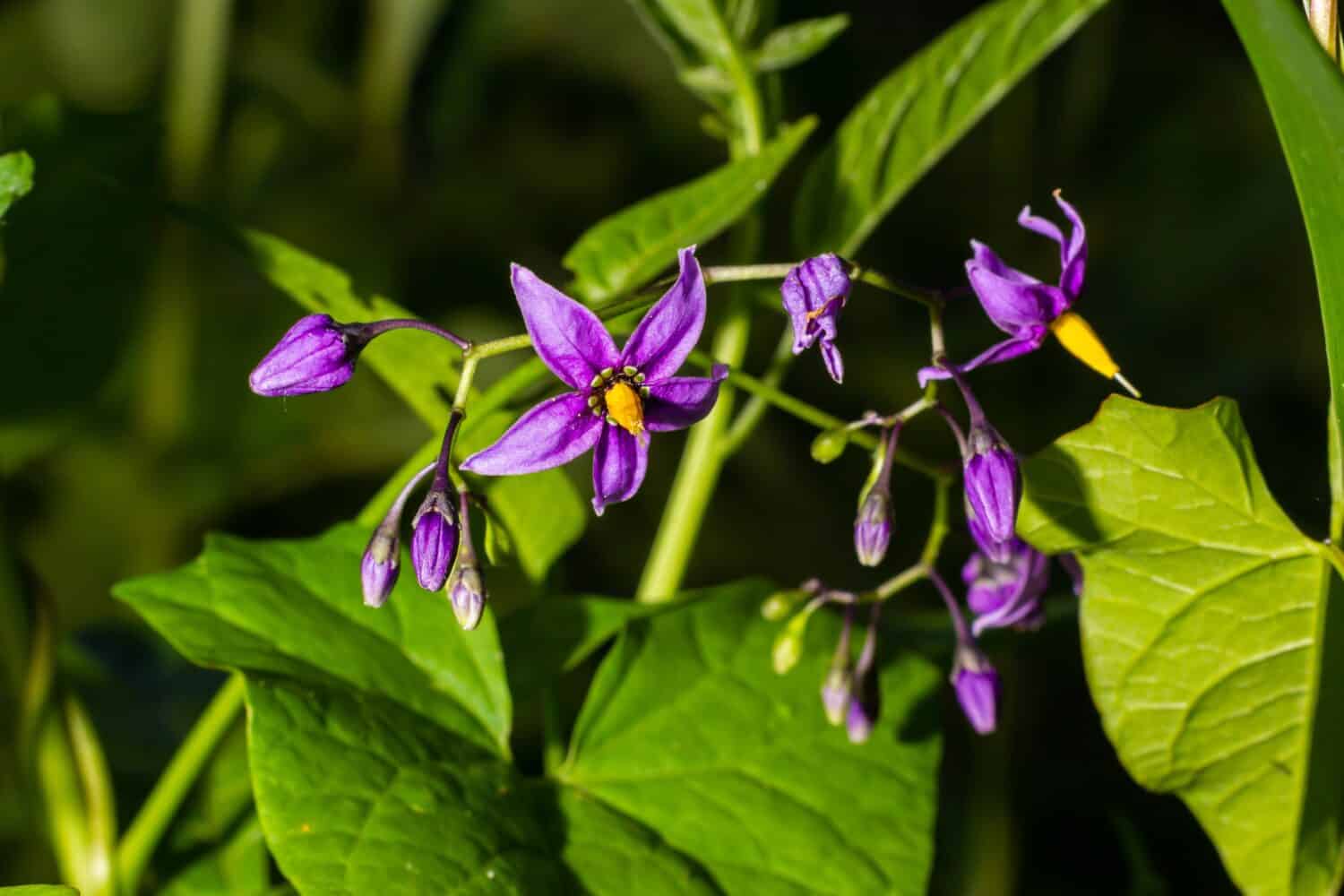
Consuming any part of the climbing nightshade plant is dangerous.
©olko1975/Shutterstock.com
Climbing nightshade, Solanum dulcamara, goes by many names. It’s sometimes called poisonberry or bittersweet. No matter what name it goes by, the plant is toxic. Just about all parts of this plant contain the toxins that make it dangerous. However, a person or animal would have to ingest the plant to get poisoned.
These plants grow in a variety of places, and that’s part of what makes this species so dangerous. It’s found in wetlands, deciduous forests, grasslands, and more.
4. Foxglove

Common foxglove is a mainstay in many home gardens, but it’s potentially dangerous.
©iStock.com/Elmar Langle
Foxglove, Digitalis genus, may be a surprising entry on this list. After all, the plant is often found in many home gardens. This tall, beautiful plant with bell-shaped blooms and vivid colors looks great. However, it does come with some natural danger.
The plant grows in many different places naturally such as woodlands and coastal areas. It’s commonly grown in gardens. However, consuming parts of the plant or water that held the flowers could lead to poisoning in humans and animals, resulting in heart problems via digoxin poisoning.
5. Poison Ivy, a Common Poisonous Plant to Avoid in West Virginia
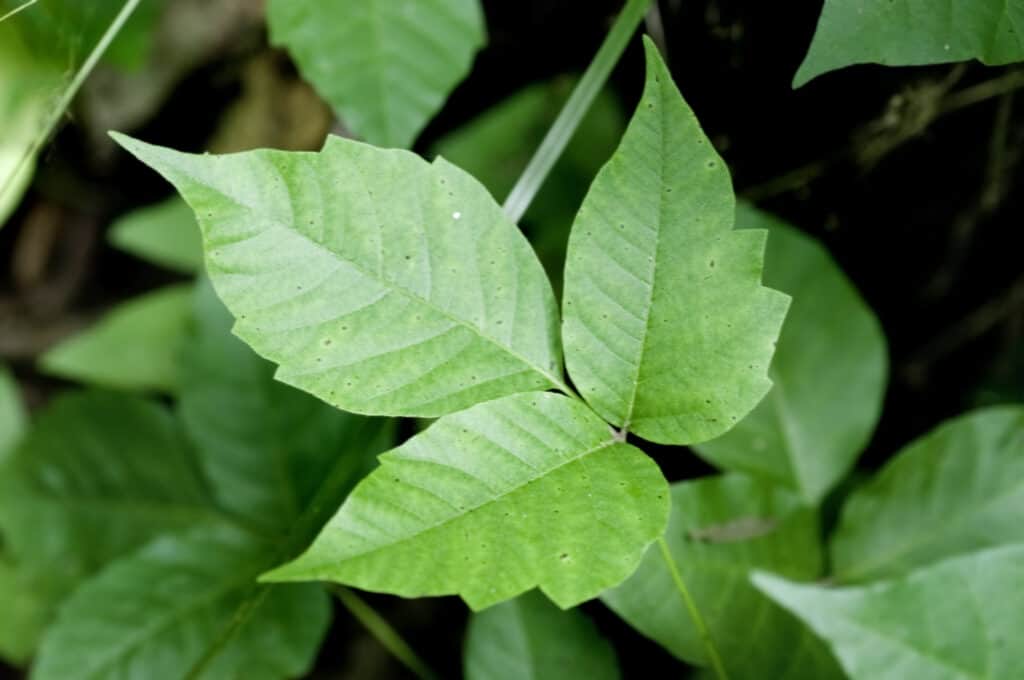
The poison ivy plant has compound leaves consisting of three individual leaflets.
©Tim Mainiero/Shutterstock.com
Poison ivy, from the genus Toxicodendron, is a fairly common plant in West Virginia. The plant is not poisonous in the same way that hemlock is poisonous. Instead, the plant mostly causes problems when a person comes in contact with its sap or other fluids. These fluids are allergenic, causing rashes in many cases but also more serious symptoms.
Poison ivy grows in fields, wetlands, forests, and many other places. It’s good to learn how to differentiate this plant before hiking in places that could have it.
6. Common Moonseed
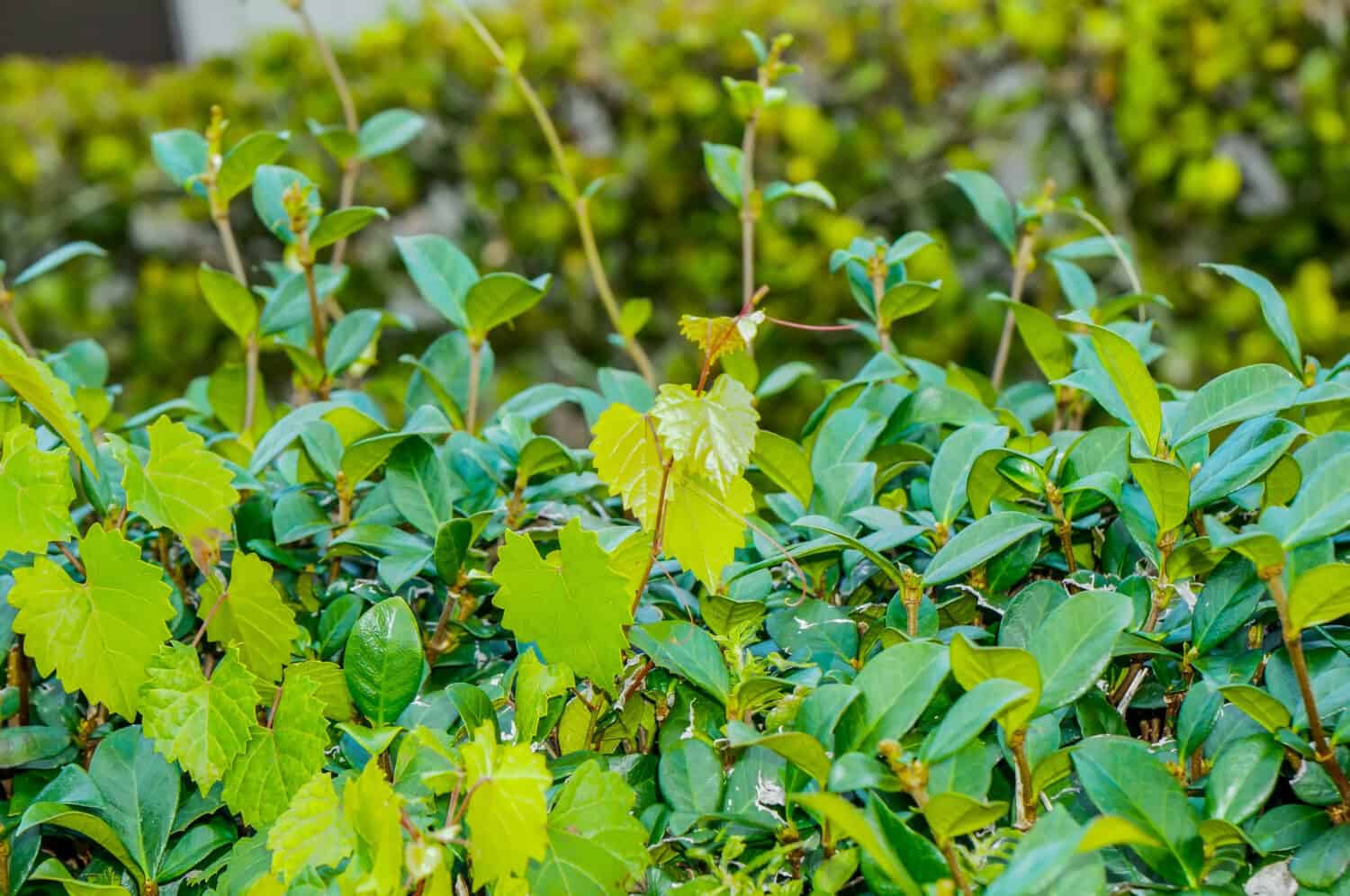
Moonseed fruit can resemble wild grapes, leading to accidental poisonings.
©jaimie tuchman/Shutterstock.com
Common moonseed, Menispermum canadense, is a woody vine that can grow upwards of 20 feet in length! This plant’s vine and fruit are similar to a grape, and misidentification can lead to an individual being poisoned. The common moonseed grows in thickets, woods, and the banks of slow-moving bodies of water.
Every part of this plant is poisonous and can cause harm to humans and animals. The fruit is also poisonous and can result in fatal poisoning.
7. Amur Honeysuckle
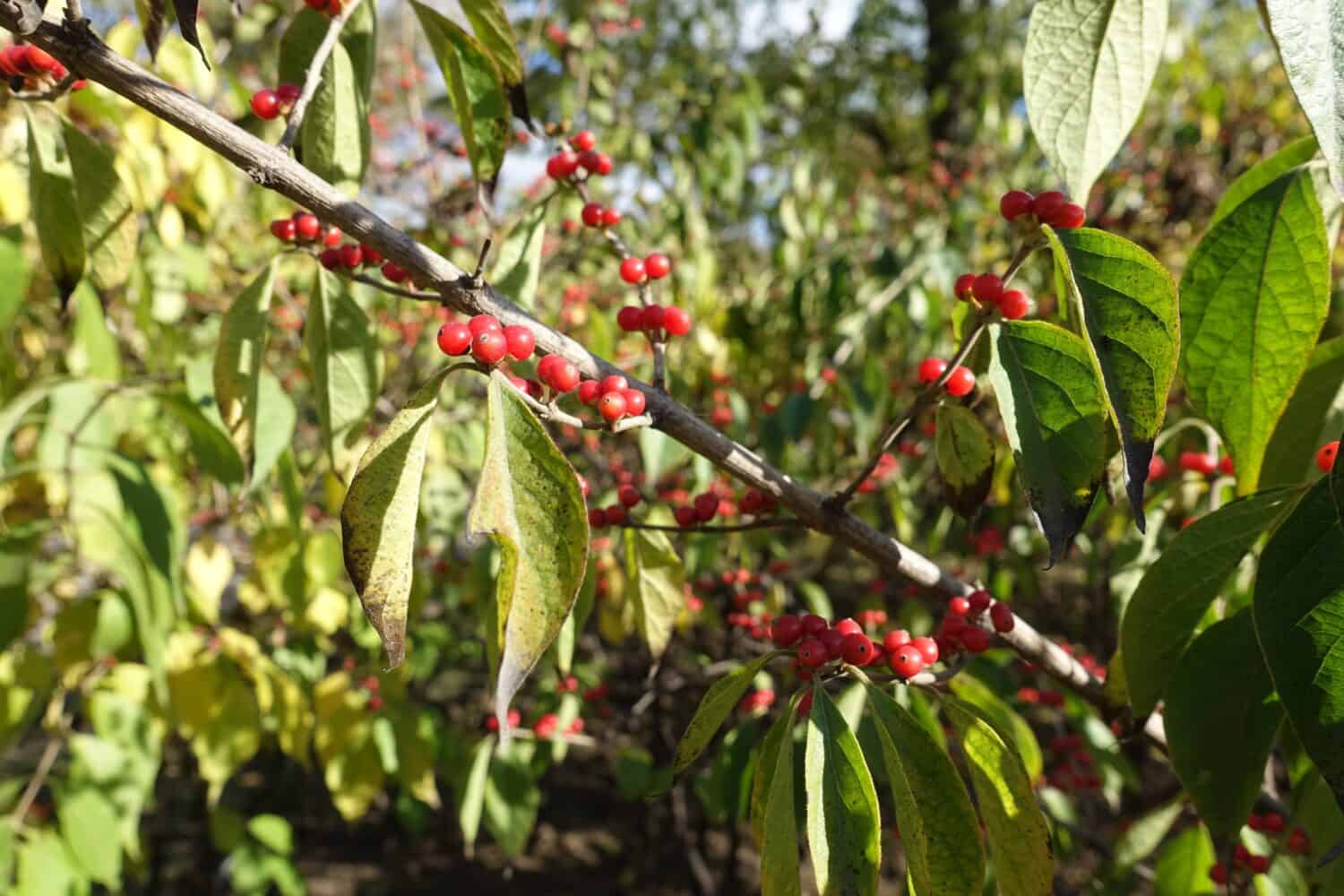
The amur honeysuckle produces berries that cause illness in humans, cats, and dogs.
©APugach/Shutterstock.com
The amur honeysuckle, Lonicera maackii, is a large shrub that grows in woodlands, shady grasslands, and near homes where it’s purposely cultivated to form a hedge. Honeysuckles often smell good, and people even consume their nectar.
However, the amur honeysuckle’s berries are poisonous, and they can lead to a person becoming seriously ill. Common symptoms in humans include diarrhea and a rapid heartbeat. Also, these berries can harm cats and dogs as well.
8. Poison Sumac
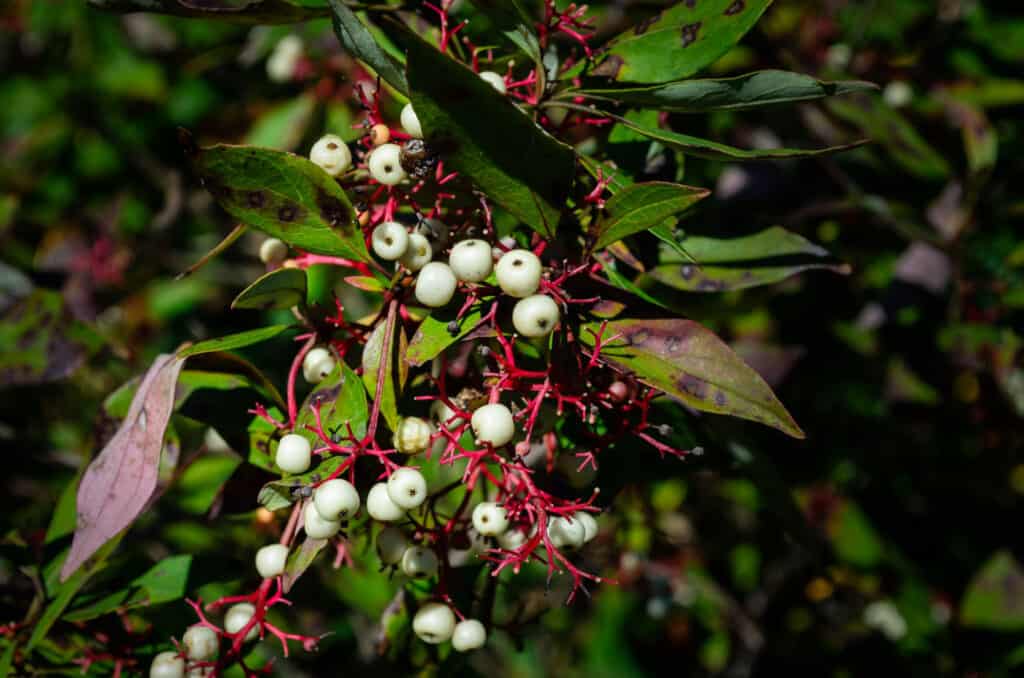
The white berries found on poison sumac should make this identification easy.
©G_r_B/Shutterstock.com
Poison sumac, Toxicodendron vernix, is another one of the most dangerous poisonous plants to avoid in West Virginia. This plant has red stems and leaves that are red, yellow, green, or orange depending on the time of year. The plant is rare in West Virginia. However, it may be found around the state’s border with Maryland.
Oftentimes, the plant grows in wetlands like marshes, swamps, bogs, and thickets near rivers. This plant can cause urushiol-induced contact dermatitis if a person touches the sap or juice of the plant. Consuming the plant can be harmful or fatal.
9. Jimsonweed

The Jimsonweed plant goes by many names including the Devil’s Trumpet.
©weha/Shutterstock.com
Jimsonweed, Datura stramonium, is a poisonous plant that grows well in many places including farmlands, pastures, fields, and even on the side of the road. The plant’s poison is found in all of its parts, but it’s especially strong in the seeds and leaves of the plant.
If the plant is consumed, it can cause altered mental states, confusion, aggression, altered heart rates, and other ailments. The plant is toxic enough to kill humans and animals, but it’s rare for animals to consume it due to its taste.
10. Giant Hogweed, a Poisonous Plant Near West Virginia
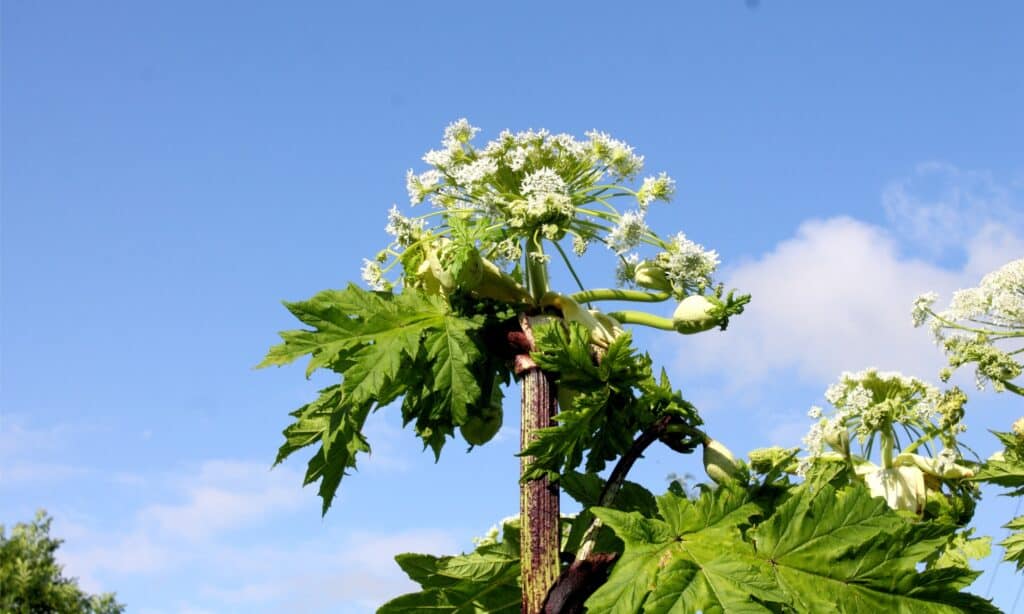
The giant hogweed has purple splotches on its stem that make it easy to identify.
©iStock.com/SailsKool
Giant hogweed, Heracleum mantegazzianum, is not yet a poisonous plant to avoid in West Virginia, but it could be coming soon. Botanists identified this plant in Virginia in June 2018, and there is some worry that the 15-foot-tall plant could make its way to West Virginia, harming people along the way.
Giant hogweed grows in moist areas near rivers, meadows, and streams. However, it can also grow along the edges of forests and in people’s backyards. Contact with this plant’s sap can make a person’s skin sensitive to sunlight, causing a severe burn. If the sap gets in a person’s eyes, it can lead to permanent blindness. While it may not be poisonous in the sense that a person must ingest it to be harmed, the giant hogweed is still very dangerous to humans even with a short exposure.
There are several dangerously poisonous plants to avoid in West Virginia. Learning how to identify plants before consuming them is very important for a person that spends time outdoors. A safe practice is to not eat wild plants of unknown origin. Furthermore, it’s wise to dress for safety when going on outdoor excursions. That way, plants like poison ivy and poison sumac do not have a high likelihood of ruining one’s hike or fishing trip.
Summary Of 10 Dangerously Poisonous Plants To Avoid In West Virginia
| Rank | Plant |
|---|---|
| 1 | Poison Hemlock |
| 2 | Canada Yew |
| 3 | Climbing Nightshade |
| 4 | Foxglove |
| 5 | Poison Ivy |
| 6 | Common Moonseed |
| 7 | Amur Honeysuckle |
| 8 | Poison Sumac |
| 9 | Jimsonweed |
| 10 | Giant Hogweed, Near West Virginia |
The photo featured at the top of this post is © iStock.com/hapelena
Thank you for reading! Have some feedback for us? Contact the AZ Animals editorial team.






